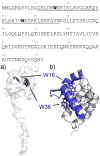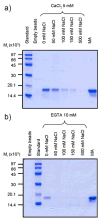Calmodulin disrupts the structure of the HIV-1 MA protein
- PMID: 20488189
- PMCID: PMC2902600
- DOI: 10.1016/j.jmb.2010.05.022
Calmodulin disrupts the structure of the HIV-1 MA protein
Erratum in
- J Mol Biol. 2011 Oct 28;413(3):742
Abstract
The MA protein from HIV-1 is a small, multifunctional protein responsible for regulating various stages of the viral replication cycle. To achieve its diverse tasks, MA interacts with host cell proteins and it has been reported that one of these is the ubiquitous calcium-sensing calmodulin (CaM), which is up-regulated upon HIV-1 infection. The nature of the CaM-MA interaction has been the subject of structural studies, using peptides based on the MA sequence, that have led to conflicting conclusions. The results presented here show that CaM binds intact MA with 1:1 stoichiometry in a Ca(2+)-dependent manner and that the complex adopts a highly extended conformation in solution as revealed by small-angle X-ray scattering. Alterations in tryptophan fluorescence suggest that the two buried tryptophans (W16 and W36) located in the first two alpha-helices of MA mediate the CaM interaction. Major chemical shift changes occur in the NMR spectrum of MA upon complex formation, whereas chemical shift changes in the CaM spectrum are quite modest and are assigned to residues within the normal target protein-binding hydrophobic clefts of CaM. The NMR data indicate that CaM binds MA via its N- and C-terminal lobes and induces a dramatic conformational change involving a significant loss of secondary and tertiary structure within MA. Circular dichroism experiments suggest that MA loses approximately 20% of its alpha-helical content upon CaM binding. Thus, CaM binding is expected to impact upon the accessibility of interaction sites within MA that are involved in its various functions.
Copyright (c) 2010 Elsevier Ltd. All rights reserved.
Figures






Similar articles
-
Calmodulin binds a highly extended HIV-1 MA protein that refolds upon its release.Biophys J. 2012 Aug 8;103(3):541-549. doi: 10.1016/j.bpj.2012.06.042. Biophys J. 2012. PMID: 22947870 Free PMC article.
-
Solution structure of calmodulin bound to the binding domain of the HIV-1 matrix protein.J Biol Chem. 2014 Mar 21;289(12):8697-705. doi: 10.1074/jbc.M113.543694. Epub 2014 Feb 5. J Biol Chem. 2014. PMID: 24500712 Free PMC article.
-
NMR, biophysical, and biochemical studies reveal the minimal Calmodulin binding domain of the HIV-1 matrix protein.J Biol Chem. 2011 Sep 23;286(38):33533-43. doi: 10.1074/jbc.M111.273623. Epub 2011 Jul 28. J Biol Chem. 2011. PMID: 21799007 Free PMC article.
-
Structure, dynamics and interaction with kinase targets: computer simulations of calmodulin.Biochim Biophys Acta. 2004 Mar 11;1697(1-2):289-300. doi: 10.1016/j.bbapap.2003.11.032. Biochim Biophys Acta. 2004. PMID: 15023369 Review.
-
The Merck Frosst Award Lecture 1994. Calmodulin: a versatile calcium mediator protein.Biochem Cell Biol. 1994 Sep-Oct;72(9-10):357-76. Biochem Cell Biol. 1994. PMID: 7605608 Review.
Cited by
-
Binding of calmodulin to the HIV-1 matrix protein triggers myristate exposure.J Biol Chem. 2010 Dec 31;285(53):41911-20. doi: 10.1074/jbc.M110.179093. Epub 2010 Oct 18. J Biol Chem. 2010. PMID: 20956522 Free PMC article.
-
Role of Gag and lipids during HIV-1 assembly in CD4(+) T cells and macrophages.Front Microbiol. 2014 Jun 25;5:312. doi: 10.3389/fmicb.2014.00312. eCollection 2014. Front Microbiol. 2014. PMID: 25009540 Free PMC article. Review.
-
The motif of human cardiac myosin-binding protein C is required for its Ca2+-dependent interaction with calmodulin.J Biol Chem. 2012 Sep 7;287(37):31596-607. doi: 10.1074/jbc.M112.383299. Epub 2012 Jul 16. J Biol Chem. 2012. PMID: 22801425 Free PMC article.
-
HIV-1 Virus Interactions With Host Proteins: Interaction of the N-terminal Domain of the HIV-1 Capsid Protein With Human Calmodulin.Nat Prod Commun. 2019 May;14(5):10.1177/1934578X19849190. doi: 10.1177/1934578X19849190. Epub 2019 May 28. Nat Prod Commun. 2019. PMID: 31388391 Free PMC article.
-
Role of the HIV-1 Matrix Protein in Gag Intracellular Trafficking and Targeting to the Plasma Membrane for Virus Assembly.Front Microbiol. 2012 Feb 17;3:55. doi: 10.3389/fmicb.2012.00055. eCollection 2012. Front Microbiol. 2012. PMID: 22363329 Free PMC article.
References
-
- Radding W, Pan ZQ, Hunter E, Johnston P, Williams JP, McDonald JM. Expression of HIV-1 envelope glycoprotein alters cellular calmodulin. Biochem Biophys Res Commun. 1996;218:192–7. - PubMed
-
- Radding W, Williams JP, McKenna MA, Tummala R, Hunter E, Tytler EM, McDonald JM. Calmodulin and HIV type 1: interactions with Gag and Gag products. AIDS Res Hum Retroviruses. 2000;16:1519–25. - PubMed
-
- Mervis RJ, Ahmad N, Lillehoj EP, Raum MG, Salazar FH, Chan HW, Venkatesan S. The gag gene products of human immunodeficiency virus type 1: alignment within the gag open reading frame, identification of posttranslational modifications, and evidence for alternative gag precursors. J Virol. 1988;62:3993–4002. - PMC - PubMed
Publication types
MeSH terms
Substances
Grants and funding
LinkOut - more resources
Full Text Sources
Miscellaneous

